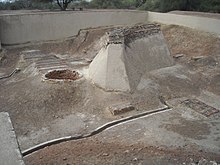Harappa
Appearance
English
[edit]
Etymology
[edit]Borrowed from Punjabi ہَڑَپَّہ (haṛappah) / ਹੜਪ੍ਪਾ (haṛppā). (This etymology is missing or incomplete. Please add to it, or discuss it at the Etymology scriptorium. Particularly: “Do we know the meanings or origins of these words? Are they derived from Sanskrit?”)
Proper noun
[edit]Harappa
- A village in Punjab, in eastern Pakistan.
- An archaeological site near the village; the ancient city excavated at the site.
- 1995, Karl J. Schmidt, An Atlas and Survey of South Asian History[1], page 12:
- The site, known as Harappa, contained evidence of a culture over 1,000 years older than any other yet discovered in South Asia and one which dated back to c. 2350 BCE, making it one of the four oldest centers of civilization in the world.
- 1996, Elizabeth E. Broadrup, "Kot Diji (Sind, Pakistan)," article in Trudy Ring, Robert M. Salkin, Sharon La Boda (editors), International Dictionary of Historic Places, Volume 5: Asia and Oceania, page 489,
- Now considered the first urban culture of the Indian subcontinent, the Harappan civilization was unknown to scholars until the twentieth century. Intrigued by large, earth-covered mounds at Harappa, on the Ravi River in the Punjab province of present-day Pakistan, archaeologists began excavating the site in 1921.
- 2003, Himanshu Prabha Ray, The Archaeology of Seafaring in Ancient South Asia[2], page 91:
- Renewed excavations at Harappa from 1986 onwards and at several other sites have produced a series of radiocarbon dates.
- 2006, Karen Tate, Sacred Places of Goddess: 108 Destinations[3], page 207:
- Within the confines of Mohenjo-daro and Harappa, two of the more famous of the many ancient archaeological sites from the Indus Valley Civilization (IVC), we find evidence of the oldest forms of Goddess worship.
- 2008, Jane McIntosh, The Ancient Indus Valley: New Perspectives[4], page 385:
- The early picture of the Indus civilization was largely based on what was revealed by excavations in the two great cities of Mohenjo-daro and Harappa.
- (attributive use) The Harappan Civilization, or Indus Valley Civilization, a Bronze Age civilization that flourished in a large region encompassing the site.
- 1989, Amalananda Ghosh (editor), "Rangpur," entry in An Encyclopaedia of Indian Archaeology, page 370,
- He declared that it was a site of the late period of Harappa culture [4.9] on the basis of certain pottery types and painted designs thereon and that 'the mere fact that the Indus culture is by this discovery pushed so far s.-e. as Kathiawar is a matter of great importance'.
- 1989, Amalananda Ghosh (editor), "Rangpur," entry in An Encyclopaedia of Indian Archaeology, page 370,

